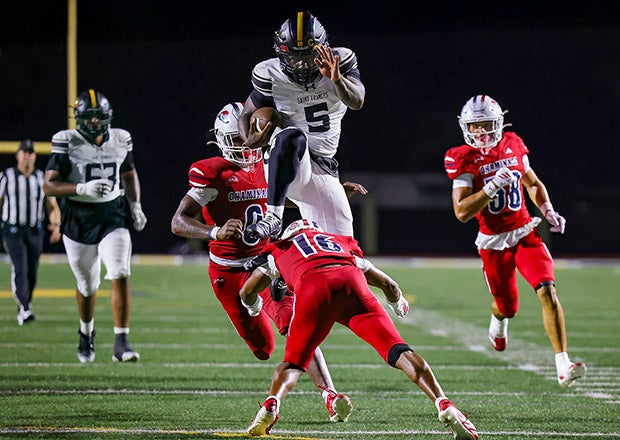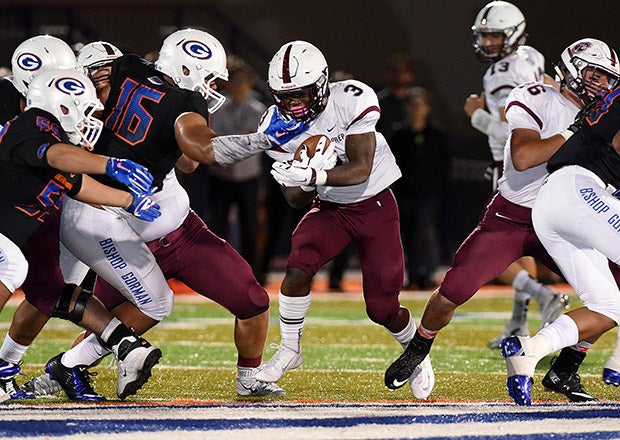Toledo powerhouses Scott and Waite were way ahead of their time in the 1920s putting together schedules that featured teams from all over the country.
Several teams in the MaxPreps Top 25 high school football rankings have made a concerted effort to give their schedules a very "national" flavor.
No. 1
St. John Bosco (Bellflower, Calif.) has played games against teams from Florida, Texas, Hawaii and Maryland and those games might not even be the toughest part of the schedule. The Braves also play the other five members of the Trinity League, arguably the toughest in the country.
Likewise, teams like No. 2
St. Frances Academy (Baltimore, Md.), No. 3
Grayson (Loganville, Ga.), No. 4
IMG Academy (Bradenton, Fla.), No. 5
Centennial (Corona, Calif.), No. 6
Mater Dei (Santa Ana, Calif.) and No. 7
Bishop Gorman (Las Vegas, Nev.), will combine to play 26 out-of-state opponents by season's end.

No. 2 St. Frances Academy has already played games in California, Florida and Pennsylvania this season. The Panthers close out the season with a return to Florida to face IMG Academy. (PHOTO: Jeff Klein)
This type of scheduling makes sense for those programs that want to face the toughest opponents and a build a resume that can lead to consideration for a national championship. Airline travel today makes such a schedule possible, allowing teams to quickly fly to their game destination within a few hours time, play the game and then head home.
Some of these teams travel thousands of miles to face an opponent, something that would have seemed unimaginable 100 years ago when traveling great distances often took days by train since commercial airline travel did not become popular until after World War II.
But that's where the conventional wisdom is wrong. In fact, claiming a national championship was all the rage back in the 1920s with teams traveling across the Midwest, and sometimes across the country, to play inter-sectional "national championship" games at season's end.
Two teams in particular went out of their way to build a regular season schedule with the toughest opponents they could find, wherever they could find them, in a quest to make the claim that they had the best high school football team in the country. Ironically, those two schools were located just three miles from each other on either side of the Maumee River in Toledo, Ohio.
The city of Toledo was founded along Lake Erie in the 1830s during the building of the Erie Canal. The first high school formed in 1854 and closed when 1914 when
Scott and
Waite high school's were built.
As the only two high schools in town, Scott and Waite developed an intense rivalry that began with a Thanksgiving Day game in 1914. The rivalry played before huge crowds with a high of 23,000 fans attending one year. The traditional holiday game occurred every year until it was discontinued in 1962.
By the 1920s, Scott and Waite had developed strong programs. Scott claimed a national championship in 1916 after defeating several top teams in nearby Michigan and Illinois before topping Eastern powerhouse
Haverhill (Mass.) 13-0 in a "national championship" game.
Scott did it again in 1919, defeating mostly Ohio schools including Waite 6-0, and knocking off Eastern champion
Somerville (Mass.). Scott then headed West to take on Pacific Coast champion
Everett (Wash.). A total of 21 players and 13 coaches, fans, newspapermen and faculty headed out by train on December 19 for a tour that included stops at the Grand Canyon, Los Angeles, San Francisco, Portland, Seattle, Vancouver (British Columbia) and finally Everett.
The two teams played on New Year's Day of 1920, battling to a 7-7 tie, with both claiming a share of the national championship.
Waite won the rivalry game against Scott in 1921 but Duvall County (Jacksonville, Fla.) claimed the national title that year based on a win over Dayton Steele (Ohio).
By 1922, both Scott and Waite began scheduling opponents from across the country as part of their regular season schedule. This scheduling strategy led to two rival schools battling for national championship honors three straight seasons.
As Tim Hudak pointed out in his book "All the Way To No. 1", which chronicles the history of national high school championship games and national championship teams, The 1922-24 era in Toledo marked a time when the annual national championship was not determined in a postseason game, but in the annual Scott-Waite Thanksgiving Day rivalry contest.
Scott, which claimed the national championship in 1922, took on teams from Michigan and Wisconsin, and also defeated Waite, 15-14, before traveling to
Corvallis (Ore.) on New Year's Day for a 32-0 win.
Waite had an even more ambitious schedule and would likely have been the national champion if not for the one-point loss to Scott. Prior to the start of the 1922 season, the Dayton Daily News reported the following about Waite's schedule.
"Waite High School this season faces what is considered by football fans the stiffest schedule arranged for a scholastic team," the Daily News reported. "Coach Larry Bevan, confident that Waite will be better and stronger this year than in the fall of 1921, prevailed upon the faculty manager to seek national schoolboy honors for his eleven."
Bevan set up games with sectional champions from other states, including
Male (Louisville, Ky.), Harrisburg Park (Buffalo, N.Y.), Hasten (Buffalo, N.Y.),
Parkersburg (W.Va.),
Washington (Cedar Rapids, Iowa) and South Bend (Ind.). Although Waite lost to Scott, it went on to play
Malden (Mass.) in a postseason game.
Scott claimed the national championship again in 1923, thanks to a 14-13 win over Waite on Thanksgiving Day. Scott also played
Moline (Ill.),
Watertown (Mass.), Spokane (Wash.), Washington (Cedar Rapids, Iowa) and Portland Columbia Prep (Ore.).
Waite claimed the national championship in 1924 with a 13-6 win over Scott. The Indians also defeated
Morenci (Mich.), Detroit Northern (Mich.), Lake Charles (La.),
Memphis Central (Memphis, Tenn.),
Bloomington (Ill.),
Peru (Ind.) and
Everett (Mass.).
Other schools across the country began to build national schedules as well. Washington (Cedar Rapids, Iowa), which had won national championships in track and field and basketball earlier in the 1920s, also laid claim to the 1924 national championship in football (also claimed by Waite) after beating
Bowen (Chicago, Ill.), Moline (Ill.),
Washington (Sioux Falls, S.D.),
Stillwater (Minn.),
DuPont Manual (Louisville, Ky.) and Harrisburg Tech (Pa.).
Pine Bluff (Ark.) claimed the national championship in 1925 after traveling to Tennessee, Texas, and Georgia during a 16-0 season. The season culminated with a 61-0 win over Dayton Stivers (Ohio) in a national championship game.
The 1920s were a prosperous time in the United States and especially Toledo, which was home to the second-largest car manufacturer in the country (Willys-Overland). Toledo was also home to the largest glass company in the world, the Owens-Illinois Glass Company, during the 1920s, thus solidifying Toledo's reputation as "The Glass City."
But those prosperous times ended with the advent of the Great Depression in 1929. As a result, extensive traveling for high school football games began to wane. World War II severely curtailed high school sports travel in 1941 due to the rationing of rubber and gasoline.
The schedules of teams claiming national championships in the 1930s and beyond show this change. While the 1932 Waite team that claimed the national championship that season did play three out-of-state teams in the regular season and traveled to Florida to play
Miami in December, eight of its opponents were from Ohio and five were from Toledo, indicating the rapid growth in the city over the previous two decades.
National championship teams from Ohio, like
Washington (Massillon) and
McKinley (Canton) only played a couple of nearby out-of-state teams while the powerful 1943 Miami (Fla.) team played only teams from Georgia and North Carolina.
The 1941
Leo (Chicago, Ill.) team claimed the national championship without playing a team outside of the Chicago area while the
Lynn Classical (Lynn, Mass.) team claimed the national championship in 1947 without playing outside of Massachusetts.
It should be noted that Lynn Classical, led by All-American Harry Agganis, was scheduled to play Miami on Christmas Day, but Agganis and his coach declined the invitation when they were notified by game officials that they would need to leave their two Black players at home.
Lynn Classical's and Leo's championships were the first of a growing trend of teams to focus more on in-state opponents rather than national ones. State playoffs became more of a goal rather than national championships and thus "national championship games" became a thing of the past. According to Hudak, the last game dubbed a "national championship game" occurred in 1939 with Pine Bluff defeating Baton Rouge (La.) in Louisiana.
From 1947 to 2011, a total of 115 teams either claimed a national championship or were selected by a media outlet as national champions. During that time, those 115 schools combined to play just 49 out-of-state opponents. Most of those opponents were from neighboring states.
Among the rare cross-country trips during that time included
Don Bosco Prep's home game with
De La Salle (Concord, Calif.) in 2009,
Northwestern's trip to
Southlake Carroll (Southlake, Texas) in 2007 and the 1982 matchup between host
Archbishop Moeller (Cincinnati, Ohio) and
Servite (Anaheim, Calif.).
It wasn't until 2011 when
Trinity (Louisville, Ky.), which was ranked No. 1 by Rivals and Sports Illustrated, opened the season with five straight out-of-state opponents that a national champion had more than three out-of-state opponents on its schedule. Trinity knocked off
Brentwood Academy (Brentwood, Tenn.),
Montgomery Bell Academy (Nashville, Tenn.),
Elder (Cincinnati, Ohio),
St. Xavier (Cincinnati, Ohio) and
Cathedral (Indianapolis, Ind.) to begin the year en route to a 14-0 season.
By 2014, Bishop Gorman had aggressively scheduled six out-of-state opponents in
Brophy College Prep (Phoenix, Ariz.), Servite,
Bingham (South Jordan, Utah), Centennial (Corona, Calif.),
Santa Margarita (Rancho Santa Margarita, Calif.) and St. John Bosco en route to a 15-0 record and a national championship.
The 2015 Bishop Gorman team went 15-0 with another national championship while scheduling
Chandler (Ariz.), Bingham,
Bellevue (Wash.),
Long Beach Poly (Long Beach, Calif.), Servite and Don Bosco Prep. Teams in contention for No. 1 have followed the national scheduling trend ever since.
Scott and Waite are no longer national powers like they were in the 1920s. Waite has won just one Toledo City League football championship since 1963 and has had a winning record just twice in the past 20 seasons. Similarly, Scott has just five winning records in the past 20 years and has won just one league championship since 1985. Waite and Scott tied for the city league championship in 2014.
The two teams still play each year, but no longer on Thanksgiving Day, and no longer for a national championship. Scott and Waite will meet today in a City League game with Scott sporting a 2-5 record and Waite a 3-4 mark.
Neither team ventures far outside the city limits for games anymore with most of the schedule filled with Toledo opponents. But there was a moment in history when Waite and Scott were way ahead of their time. They were the trendsetters and national championship contenders. Their scheduling strategy, developed over 100 years ago, is a template for how teams contend for a national championship today.

MaxPreps was there in 2015 when Don Bosco Prep of New Jersey went across the country to face defending national champion Bishop Gorman. (PHOTO: Jann Hendry)